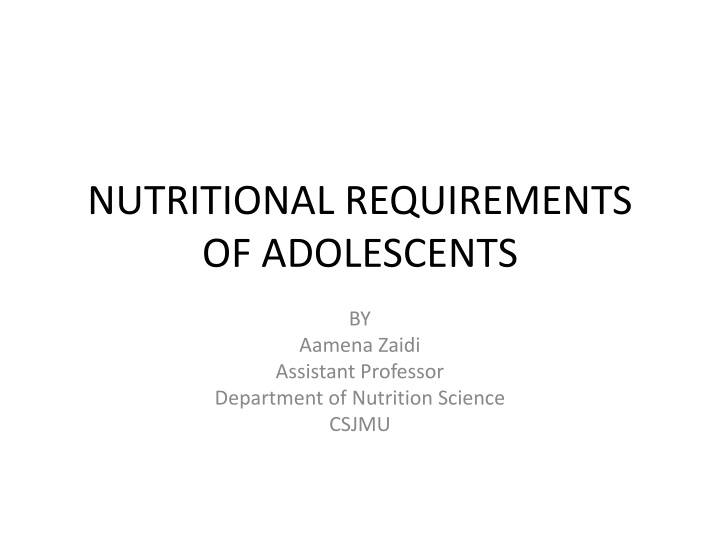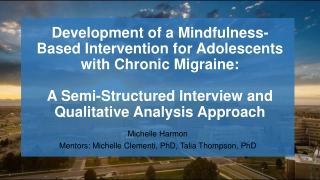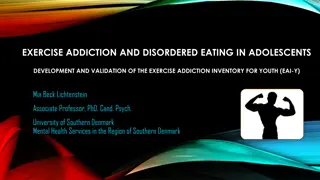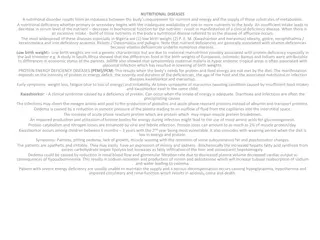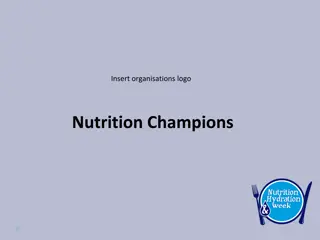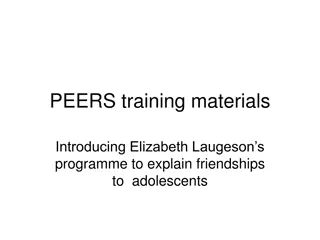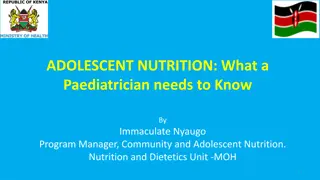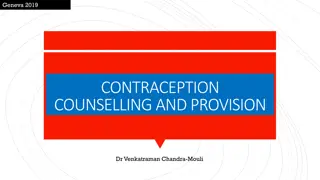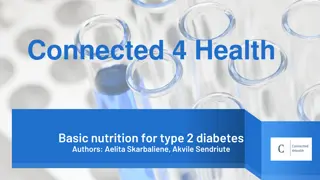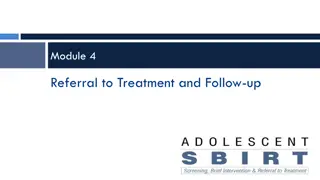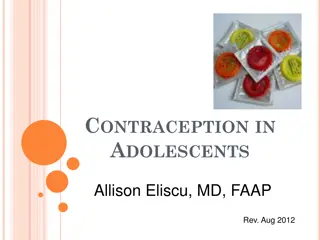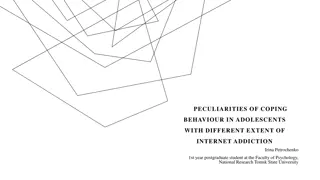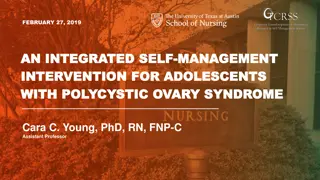Nutritional Requirements of Adolescents: Understanding Growth and Energy Needs
Adolescence is a crucial period of physical and emotional development, impacting energy, protein, and nutrient requirements. A balanced diet with adequate calories, protein, and essential fatty acids is essential for healthy growth and development during this transitional phase. Learn about the specific dietary needs of adolescents to support their optimal growth, body composition, and overall well-being.
Download Presentation

Please find below an Image/Link to download the presentation.
The content on the website is provided AS IS for your information and personal use only. It may not be sold, licensed, or shared on other websites without obtaining consent from the author.If you encounter any issues during the download, it is possible that the publisher has removed the file from their server.
You are allowed to download the files provided on this website for personal or commercial use, subject to the condition that they are used lawfully. All files are the property of their respective owners.
The content on the website is provided AS IS for your information and personal use only. It may not be sold, licensed, or shared on other websites without obtaining consent from the author.
E N D
Presentation Transcript
NUTRITIONAL REQUIREMENTS OF ADOLESCENTS BY Aamena Zaidi Assistant Professor Department of Nutrition Science CSJMU
According to WHO, individuals between 10 and 19 years are considered adolescents. The period of transition from childhood to adulthood is called adolescence with accelerated physical, biochemical and emotional development. There are many physical and mental changes which result due to the influence of hormones. It is during this period that the final growth spun occurs with increase in height and weight. The growth spurt of boys is slower than that of girl The growth spurt signals the onset of critical body composition of 10 per cent body fat.
They attain their adult stature between 18-20 but bone mass continues to increase up to age of 25. With the profound growth of adolescence there is increased demands for energy, protein, minerals and vitamins Body composition also changes during puberty. Lean body mass doubles in boys between 10- 17 years of age.
NUTRITIONAL REQUIREMENTS ENERGY- Although individual needs vary, girls consume fewer kilo calories than boys. Boys need 2750-3020 kcal a day. Sometimes the large appetite characteristic of this growth period leads adolescents to satisfy their hunger with snack foods that are high in sugar and fat and low in protein. Growth and physical activity contribute significantly to the total energy requirement.
PROTEIN-The protein intake usually exceeds 1g/kg body wt. This meets growth needs and for the pubertal changes and for developing muscle mass. The protein requirements for both boys and girls are the same up to the age of ten years. But there is a gradual difference in their requirements from the age of 13 years where the boys have a higher requirement compared to girls. Between 10-12 years the requirement of protein for girls is higher compared to boys.
FAT AND ESSENTIAL FATTY ACIDS Total fat intake below 25% E is considered to affect growth in children and adolescents. Food low in fat, saturate fat and trans fat should be emphasized in meal planning. The desirable level viable fat intake for adolescents is 35-50 g/day. The essential fatty acid requirements is 3% E. Alpha-linolenic acid helps in relaxing muscles and blood vessels of the menstrual cramps. It also reduces inflammation of mucous membrane of the uterus. Thus it reduces abdominal pain before, during and after menstrual periods. uterus and reduces
MINERALS During adolescence, 800 mg of calcium and 800 mg of phosphorus per day is needed. Bone growth demands calcium. About 150 mg of calcium must be retained every day to allow for the increase in bone mass.Ca: P ratio of 1: 1 should be maintained. Iron is needed for haemoglobin synthesis.Girls need to ensure adequate intake of iron as they lose 0.5 mg/day by way of menstruation.
If this lost iron is not replaced, it predisposes to iron deficiency anaemia. Iron is also needed for the synthesis of myoglobin which involved in muscle growth. The additional requirement of iron during adolescence is due to growth spurt, expansion of blood volume and increase in Hb concentration. Zinc deficiency is not normally seen in adolescents. Zinc supplements have been shown to increase pubertal growth in adolescents.
VITAMINS Skeletal growth requires vitamin D while the structural and functional integrity of newly formed cells depends on the availability of vitamins A, C and E. The Expert Committee recommends daily allowance of 600 jug of retinol for adolescents. The need for thiamine, riboflavin and niacin increases directly with increased caloric intake. Folacin and Vitamin B12 are essential for DNA synthesis. Tissue growth involves amino acid metabolism particularly transamination to synthesize nonessential amino acids. So the requirement for B6 is increased.
WATER Best way of meeting the requirement of water is drinking plane water. Intake of 100 per cent fruit juice (without the addition of sugar), butter milk and milk should be encouraged among the adolescents.
FOOD REQUIREMENTS Physical and psychosocial pressures influence adolescent s eating habits. The adolescent girl may gain weight easily due to her physiologic sex differences associated with fat deposits during this period and comparative lack of physical activity. Social pressures and personal tensions concerning figure control may make her follow unwise, self- imposed crash diets for weight loss. Self starvation may result in complex and far reaching eating disorders like anorexia nervosa and bulimia.
Teenagers have reputation of having the worst eating habits. They may skip a meal particularly breakfast. They may eat fast foods which are generally inadequate in calcium and vitamin A but high in calories, saturate fat and sodium. Dieting places adolescents at risk for unhealthful eating and physical activity behaviors. Instead they should plan for long them behaviour changes such a avoiding eating binges, eating more fruits and vegetables, starting the day with breakfast and engaging in physical activity.
DIETARY GUIDELINES 1-Adequate well balanced nutritious foods should be taken to prevent obesity or undernutrition. 2-An adolescent girl should take enough calcium rich foods in her diet to increase bone density. This helps in delaying the onset of osteoporosis. 3-No meal of the day should be missed 4-Junk food should be avoided. 5-Food should be colourful and attractive.
6-Empty calorie foods such as carbonated beverages should be avoided. 7- Iron rich foods like non vegetarian foods and green leafy vegetables may be included in the diet to prevent anaemia. 8-Calorie and protein rich foods should be taken to support the growth spurt. 9-Inclusion of fruits and vegetables in the diet meet the vitamins,minerals and fibre requirement.
10-Eating habits should be independent of emotions. 11-Parents should encourage the adolescents (both boys and girls) to cook at home nutritious and tasty food. 12-Home based diets are best for children. 13-Adolescents need to be encouraged to do physical activity particularly outdoor games. Physical activity regulates appetite.
JUNK FOODS Foods that are high in salt, sugar, fat or calories and low in nutrient content are called Junk foods. Children, specially adolescents influenced by advertisements consume foods which a high in fat, sugar and salt. These foods are high in calories but not nutrient dense. Junk food give generally "empty calories . One of the important reasons for the rise in obesity among children is consuming junk food Salted snack foods like chips, candies, french fries and sweetened carbonated beverages are considered as junk foods.
Bakery products like cakes with icing and biscuits are mostly made with maida, saturated fat and sugar also come under the category of junk foods. Puffs and kari biscuits, get the characteristic layers due to the addition of trans and saturated fat. Increase in serving size of foods like pop corn in theatres is not desirable. Idli, vada and dosa contribute protein and vitamin requirements in addition to calories. There foods are not junk foods.J
Junk food should be restricted in the diets and occasionally consuming them may not harm the body. Pizzas are nowadays made with whole wheat flour. Addition of more vegetables make it more nutritious.Cheese present in pizzas contribute to protein requirement. Indian sweets like jalebi made with maida and sugar can also be considered as junk food.All sweets should be consumed in limited quantities due to high content of sugar and trans fats and occasional consumption may not imbalance nutrient mtake.
Milk based beverages like milk shakes and lassi either sweet or salt contain lot of sugar and salt. Most of the junk foods are processed. Limiting processed foods and outside foods, is desirable. Appreciating natural foods like fruits and nuts as snacks would pave the way to good health.
NUTRITIONAL PROBLEMS OBESITY Poor dietary habit combined with decreased physical activitywould lead to over weight and obesity.Adolescents who eat high calorie foods become over weight andf obese. Skipping meals and consuming foods that are junk also contribute to overweight.One of the most important contributing factor for obesity is frequent consumption
Consumption of high glycaemic foods may lead to hormonal and metabolic changes promoting excessive food intake. The prevalence of adolescent obesity can be reduced by initiating programmes of health and nutrition education for school children, encouraging physical activity and healthy food habits.
EATING DISORDERS Adolescent girls perceived their diets in the light of appearance and body shape while boys are more concerned by fitness and general well being. There are three recognised eating disorder viz: Anorexia nervosa, Bulimia nervosa and Binge eating disorder
ANOREXIA NERVOSA Physical signs Onset in early to middle adolescence Extremely thin or emaciated (less than 25 per cent of normal or ideal body weight) Rapid loss of weight Loss of menstrual periods Complaints of nausea, bloating, or constipation after eating normal amounts of food.
Food and exercise habits Cooking fo but not eating Rigidly avoiding specic foods, denying hunger, eating tiny portions of food . Exercising excessively. Possessing in-depth knowledge of calories and fat in foods Consuming odd food combinations Exhibiting ritualistic eating behaviors, such as cutting foods into tiny bits Avoiding social invitations because of food that might be served.
Psychological signs Feeling "fat" even when emaciated, intense fear of gaining weight, distorted body image Excessive preoccupation with weight, food, exercise, and dieting Social withdrawal, depression, moodines Emotional withdrawal Perfectionism Low self-estem Fatigue or weakness due to malnutrition.
Bulimia Nervosa Onset in late teens Eats large meals without gaining weight Calcified tissue Dental erosion and cavities Fatigue Irregular menstrual periods
Food and excersie habit Frequent binge eating Strict dieting followed by bingeing Purging via diuretics, enemas, over excercising,fasting or vomiting Hiding eating from others Avoiding social invitations
Psychological signs Excessive preoccupation with weight, food, exercise, and dieting. Feeling uncomfortable eating in front of others Feeling out of control when eating and unable to stop binges Depression, loneliness, shame, and feeling of emptiness Alcohol or drug use Realization that eating patterns are abnormal Low self-esteem.
Binge Eating Disorder Physical signs Onset at any age, often not recognized until adulthood Usually overweight or obese May have obesity-related diseases, such as type II diabetes, high blood pressure, high cholesterol
Food and excersie habits Frequent dieting Losing and regaining weight Frequent binge eating or eating when not hungry Eating to point of extreme discomfort Frequently eating large amounts in short time Hiding eating or eating only small amounts Avoiding social invitations Having difficulty exercising because of excess weight Trying to avoid physical activity
Psychological signs Depression, loneliness, shame, guilt, and emotional emptiness. Feeling out of control or uncomfortable when eating and unable to stop binges. Eating to espace from emotions Being preoccupied with food, dieting, body weight Feeling irritable when withdrawing from binge Realizing that eating patterns are abnormal Having low self-esteem
TREATMENT Eating disorders are complex problems that are best treated by a team of health care specialists including medical, psychological and nutrition professionals. Eating disorders are difficult to understand as well as treat and cure. A standard model of effective team treatment includes a physician, psychiatrist, psychotherapist and dietician.
For all ating disorders, establishing a weight goal is essential. For anorexia nervosa establishing a healthy weight loss is the first step. In Bulimia nervosa and binge eating disorder weight maintenance is encouraged. Supplementation with multi vitamin and minerals should be given to eating disorder patients. Nutrition therapy starts with food guidelines, meal plans, calories and weight goals.Oestrogen supplement is given to reinitiate menses. Psychological issues need to be addressed.
OTHER NUTRITIONAL PROBLEMS 1-Pre-disposition to osteoporosis 2-Anaemia 3-Undernutrition 4-Pre-menstrual syndrome
1-Pre-disposition to osteoporosis Excessive exercise, high fibre, low fat intake lead to low circulating estrogen levels, irregular menses and low bone mass. Predisposition to osteoporosis is in part atleast the result of dietary deficiency and exercise patterns during the developmental years. Low dietary intake of calcium rich foods such as milk in teenagers leads to calcium deficiency.
2-Anaemia Anaemia is most common in all the groups of adolescent girls.Anacinia is common in low socio economic class since intake is poor mainly due to the non-availality of healthy foods. In higher classes personal likes and dislikes and food taboos lead to anaemia. Supplementation of 100 mg iron and 0.5 mg of folic acid is given in primary health centres to 'mothers to be' under Nutrition and Health Services.
3-Under nutrition Undernutrition during adolescence, confounded by childhood marriages, leads to high mortality and morbidity among women and young children, thus perpetuating the vicious cycle ofundernutrition. While among the urban poor and rural girls, this is mainly due to their getting lower priority for the foodf over the boys.
In the upper class the weight deficit is related to personal likes and disikes and also a conscious attempt towards maintaining weight in fear of becoming overweight. Avoiding milk, peer influence, eating outside the home with poor selections, skiipping meals, food faddism and emotional disturbance may all contribute to under nutrition in adolescence.
Micronutrient deficiency disorders in adolescent phase result in growth retardation, low immunity and impaired reproductive functions. At times this may affect pregnancy related complications or results a low birth weight. Thus perpetuating the trans-generational cycle of malnutrition.
lodine is one of the essential micronutrients required for normal growth and development of the human brain and body. Adolescent girls should ensure to meet iodine requirement through fortified salt. Jodine deficiency causes hypothyroidism or goitre.
4-Pre-menstrual syndrome It is characterised by physical and psychological symptoms which occur 7-10 days prior to the onset of periods and disappear within the first day or two of menstrual flow. These include weight gain, abdominal bloating, breast engorgement and pain, constipation, peripheral oedema, headache, irritability, anxiety, depression, tension fatigue, lack of concentration, increased appetite, craving for sweet and salty foods. The etiology and pathophysiology have not been identified. Management includes reassurance, exercise and dietary modifications to meet all the nutritional requirements.
NUTRITIONAL PROGRAMMES FOR ADOLESCENTS One of the objectives of World Bank Assisted ICDS III Project is to empower adolescent girls through increased awareness to take better care of their personal and household health and nutrition issues. Adolocent girls are given 100 g/day supplementary food consisting 600 kcal and 18-20 g of protein for 300 days for school girls in the age group 11-14 and all others aged 15-18 as Take home ration at anganwadi centres. Food grains are subsidized centrally through the Govt owned Food Corporation of India and other items like fresh vegetables procured the State level. The cost of the scheme is shared by Centre and State governments.
School girls in the age group of 11-14 years attending anganwadi and the girls in the age group of 15-18 years will be provided supplementary nutrition in the form of "Take Home Ration on the lines of what is being provided to pregnant and lactating mothers.
Rajiv Gandhi Scheme for Empowerment of Adolescent girls - RGSEA- is also called Sabla . The main purpose of the scheme is to empower adolescent girls. This scheme is aimed to enhance nutritional and economic status of adolescent girls. Under the scheme 'Sabla' alescent girls are taught life skills. It focusses on their legal rights, reproductive cycle, HIV AIDS, contraception, menstrual hygiene, marriage, pregnancy and child care. These soos are imparted at ICDS centres.
Nutrition component needs to be included in the school curriculum to improve the nutritional status of adolescents. Parents, teachers and peer groups need to be role models in their life style behaviour. Nutrition effective tool in promoting healthy eating habits among adolescents. NIN study indicated a significant improvement knowledge after the intervention in the class room. education is an in the nutrition
SOME RECIPES FOR ADOLESCENTS RECIPE REASONS Samosa with chana, uthapam(cereal + pulse) to meet increase needs of calories and proteins Vada, spring rolls Rich in calories Basundi, laddo Protein rich Fresh juices Vitamin C rich Rice, rajmah,vegetable, fried rice, pav bhaji, omellete Nutritiuous and gives variety Bhel puri, roasted groundnuts Nutritious
CONCLUSION The nutritional concerns of adolescents have largely been neglected. They constitute one of the nutritionally vulnerable group who have not received the attention they deserved. Only healthy adolescent girl can become healthy mother who in turn can give birth to healthy child. 12th January is Nation Youth Day
